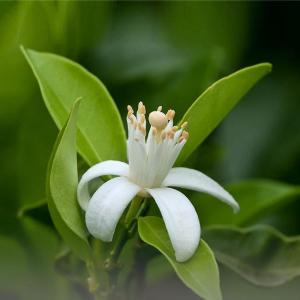
BITTER ORANGE BLOSSOM (CITRUS AURANTIUM) - PLANTS

BASE / GENERAL DATA
Information submited: May 15, 2015 Modified: May 15, 2018 By: OperaDreamhouse
The sour orange is native to southeastern Asia. Natives of the South Sea Islands, especially Fiji, Samoa, and Guam, believe the tree to have been brought to their shores in prehistoric times. Arabs are thought to have carried it to Arabia in the 9th Century. It was reported to be growing in Sicily in 1002 A.D., and it was cultivated around Seville, Spain, at the end of the 12th Century.
For 500 years, it was the only orange in Europe and it was the first orange to reach the New World.
Citrus Aurantium is an evergreen tree growing to 9 m by 6 m. It is in leaf 12 - Janua. It is in flower from April to June. The flowers arehermaphrodite (have bothmale and femaleorgans) and are pollinated by apomictic, insects.The plant is self-fertile.
The tree ranges in height from less than 3 m to 9 m, is more erect and has a more compact crown than the Sweet Orange, has smooth, brown bark, green twigs, angular when young, and flexible, not very sharp, thorns from 2,5 - 8 cm long.
The highly fragrant flowers, borne singly or in small clusters in the leaf axils, are about 3,75 cm wide, with 5 white, slender, straplike, recurved, widely-separated petals surrounding a tuft of up to 24 yellow stamens. From 5 to 12% of the flowers are male.
Its scent is sweet, honeyed and somewhat metallic with green and spicey facets.
Orange Blossom can be described as smelling sweeter, warmer and more floral than Neroli. The difference between how Neroli and Orange Blossom smell and why they are referred to with different names, is a result of the process of extraction that is used to obtain the oil from the blooms. Neroli is extracted by steam distillation and Orange Blossom is extracted via a process of enfleurage.
By the end of the 17th century, Anne Marie Orsini, duchess of Bracciano and princess of Nerola, Italy, introduced the essence of Bitter Orange tree as a fashionable fragrance by using it to perfume her gloves and her bath. Since then, the term "Neroli" has been used to describe this essence. Neroli has a refreshing and distinctive, spicy aroma with sweet and flowery notes.
The largest Bigarade - tree plantations are to be found in the South of France, in Calabria and in Sicily. The centre of the industry of Neroli oil is the South of France, where the Bitter Orange is extensively cultivated for that purpose alone.
The tree requires a dry soil with a southern aspect. It bears flowers three years after grafting, increasing every year until it reaches its maximum, when it is about twenty years old. The quantity depends on the age and situation, a full - grown tree yielding on an average 50 to 60 lb. of blossoms.One hundred Orange trees, at the age of ten years, will occupy nearly an acre of land, and will produce during the season about 2,200 lb. of Orange Flowers.
The flowering season is in May and the flowersare gathered two or three times a week, after sunrise. When the autumn is mild and atmospheric conditions are favourable, flowering takes place in October, and this supplementary harvest lasts until January, or till a frosty morning stops the flowering. These autumn flowers have much less perfume than those of the spring and the custom is to value them at only one-half the price of May flowers.
The flowers yield nectar for Honeybees.
Orange Petals are often associated with marriage, purity and brides, as brides traditionally wore Orange Buds in their hair.
Orange Flowers have been used in wedding traditions since the times of ancient China. In Chinese tradition, Orange Flowers were omens of purity, innocence and moral virtue, but also a symbol of fruitfulness and fertility. Brides of all nations have always worn some kind of a floral embellishment on their wedding day, and the tradition of using orange flowers has spread from the East to Europe, during the times of the Crusaders.
Maidens have used fresh Orange Blossoms to decorate their hair on a wedding day, and this custom was so widespread that that the expression "To Gather Orange Blossoms" took completely different connotation by starting to mean "To Seek a Wife".
The fruitof the Bitter Orange (Citrus Aurantium) is very similar to the Sweet Orange (Citrus Sinensis), but is smaller, with a diameter of only seven to eight centimetres. The sphere is slightly flattened and the skin is thicker and more dimpled than that of the Sweet Orange. The fruit flesh tastes sour, while the peel and the skin surrounding the fruit segments have a strong bitter taste. Around the Mediterranean the ripe Bitter Oranges are harvested in January and February.
For 500 years, it was the only orange in Europe and it was the first orange to reach the New World.
Citrus Aurantium is an evergreen tree growing to 9 m by 6 m. It is in leaf 12 - Janua. It is in flower from April to June. The flowers arehermaphrodite (have bothmale and femaleorgans) and are pollinated by apomictic, insects.The plant is self-fertile.
The tree ranges in height from less than 3 m to 9 m, is more erect and has a more compact crown than the Sweet Orange, has smooth, brown bark, green twigs, angular when young, and flexible, not very sharp, thorns from 2,5 - 8 cm long.
The highly fragrant flowers, borne singly or in small clusters in the leaf axils, are about 3,75 cm wide, with 5 white, slender, straplike, recurved, widely-separated petals surrounding a tuft of up to 24 yellow stamens. From 5 to 12% of the flowers are male.
Its scent is sweet, honeyed and somewhat metallic with green and spicey facets.
Orange Blossom can be described as smelling sweeter, warmer and more floral than Neroli. The difference between how Neroli and Orange Blossom smell and why they are referred to with different names, is a result of the process of extraction that is used to obtain the oil from the blooms. Neroli is extracted by steam distillation and Orange Blossom is extracted via a process of enfleurage.
By the end of the 17th century, Anne Marie Orsini, duchess of Bracciano and princess of Nerola, Italy, introduced the essence of Bitter Orange tree as a fashionable fragrance by using it to perfume her gloves and her bath. Since then, the term "Neroli" has been used to describe this essence. Neroli has a refreshing and distinctive, spicy aroma with sweet and flowery notes.
The largest Bigarade - tree plantations are to be found in the South of France, in Calabria and in Sicily. The centre of the industry of Neroli oil is the South of France, where the Bitter Orange is extensively cultivated for that purpose alone.
The tree requires a dry soil with a southern aspect. It bears flowers three years after grafting, increasing every year until it reaches its maximum, when it is about twenty years old. The quantity depends on the age and situation, a full - grown tree yielding on an average 50 to 60 lb. of blossoms.One hundred Orange trees, at the age of ten years, will occupy nearly an acre of land, and will produce during the season about 2,200 lb. of Orange Flowers.
The flowering season is in May and the flowersare gathered two or three times a week, after sunrise. When the autumn is mild and atmospheric conditions are favourable, flowering takes place in October, and this supplementary harvest lasts until January, or till a frosty morning stops the flowering. These autumn flowers have much less perfume than those of the spring and the custom is to value them at only one-half the price of May flowers.
The flowers yield nectar for Honeybees.
Orange Petals are often associated with marriage, purity and brides, as brides traditionally wore Orange Buds in their hair.
Orange Flowers have been used in wedding traditions since the times of ancient China. In Chinese tradition, Orange Flowers were omens of purity, innocence and moral virtue, but also a symbol of fruitfulness and fertility. Brides of all nations have always worn some kind of a floral embellishment on their wedding day, and the tradition of using orange flowers has spread from the East to Europe, during the times of the Crusaders.
Maidens have used fresh Orange Blossoms to decorate their hair on a wedding day, and this custom was so widespread that that the expression "To Gather Orange Blossoms" took completely different connotation by starting to mean "To Seek a Wife".
The fruitof the Bitter Orange (Citrus Aurantium) is very similar to the Sweet Orange (Citrus Sinensis), but is smaller, with a diameter of only seven to eight centimetres. The sphere is slightly flattened and the skin is thicker and more dimpled than that of the Sweet Orange. The fruit flesh tastes sour, while the peel and the skin surrounding the fruit segments have a strong bitter taste. Around the Mediterranean the ripe Bitter Oranges are harvested in January and February.

SPIRITUAL PRACTISES DATA

MEDICINE / HEALTH DATA

BEAUTY / COSMETICS DATA

FOOD / COOKING DATA
COMMENTS
No comments.


